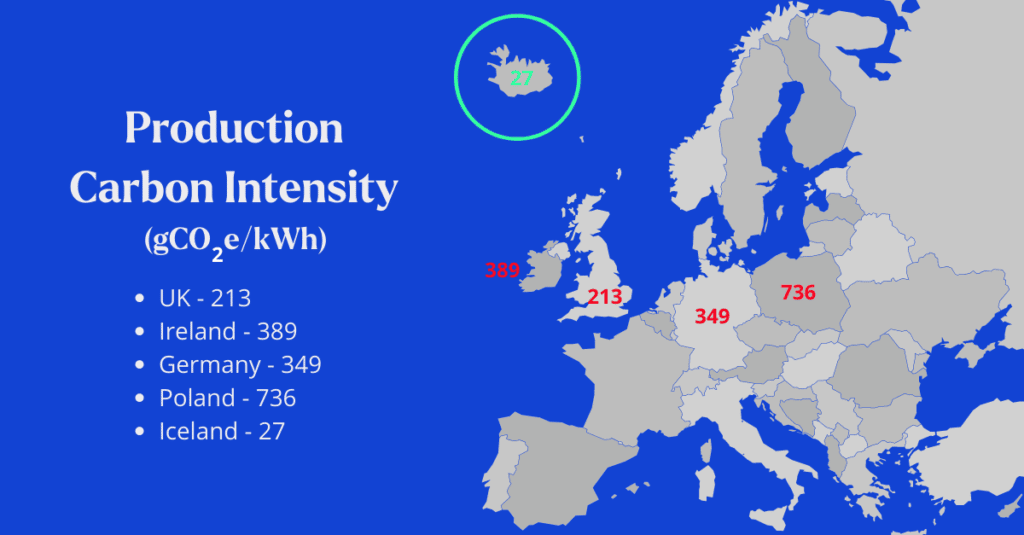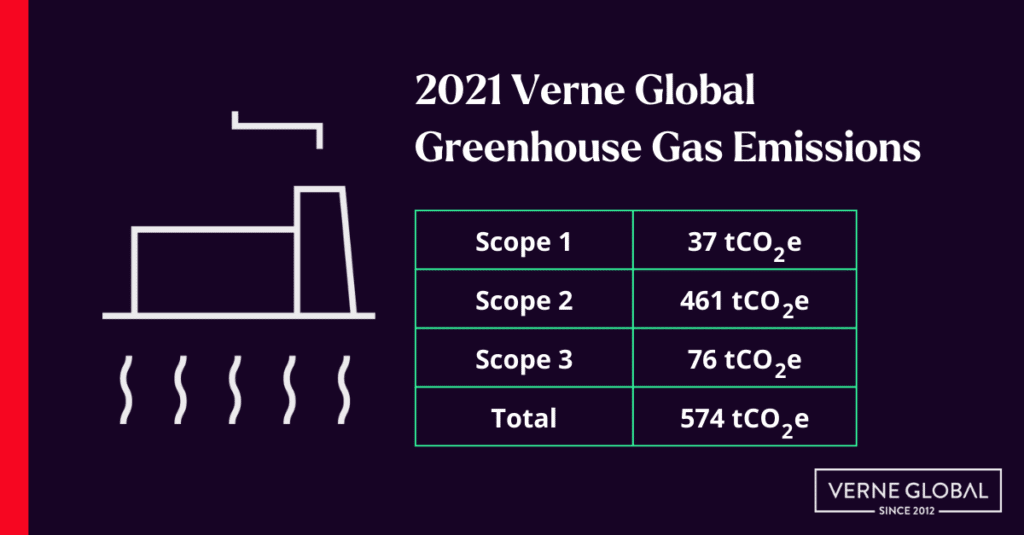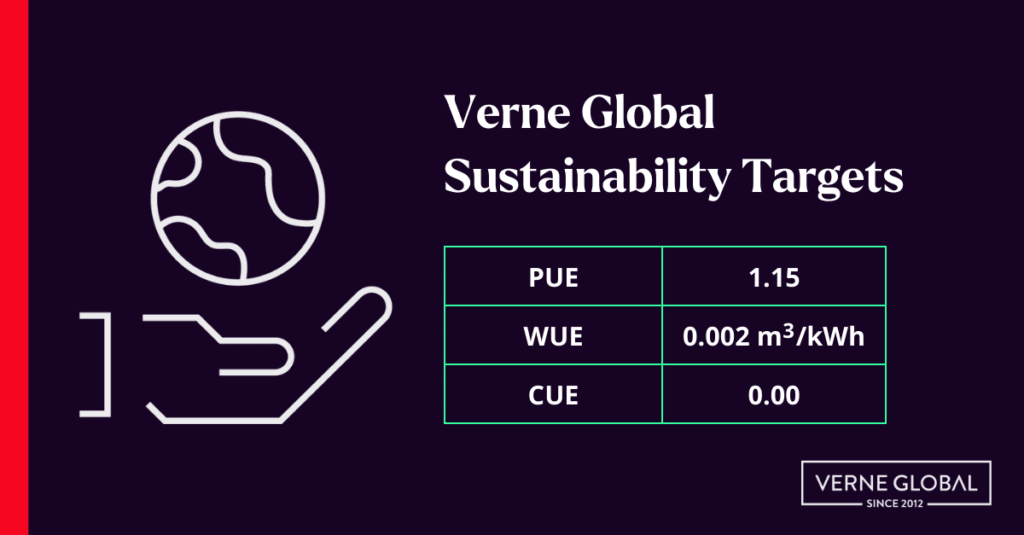Blog
07.08.2022
Verne Global’s Sustainability Call to Action
From its inception, sustainability and efficiency have been at the heart of Verne Global's mission. Now, as the industry works towards standardisation and transparency of reporting for sustainability and efficiency, Dominic Ward shares Verne Global's market-leading metrics and targets. These critical components help customers make an informed decision about data center infrastructure and where their data should be processed and stored.


From the inception of Verne Global, sustainability and efficiency have been at the heart of our mission. We searched the planet for the optimal location for data centers and decided upon Iceland. It remains the only country in the world that generates all its energy from renewable sources. Iceland has set the global benchmark for sustainability and continues to lead the way. It also has the perfect climate for operating data centers with a year-round temperate climate that enables free cooling every day of the year for even the most intense infrastructure.
After a decade of uninterrupted operations, we look back on our decision to locate our campus in Iceland with clear and simple validation that we may have been early, but we were right. Our first customers were bold, forward-thinking, and perhaps a little ahead of their time. They saw the cost, efficiency, and sustainability benefits of optimising the location and infrastructure of their workflows and applications. Now, ten years on, this kind of optimisation is critical and easier to achieve than ever before.
Optimisation of location and infrastructure
Only recently has the global data center industry finally grasped the importance of sustainability and efficiency, largely driven by customer focus and demand. Yet, there remains no consistency in measurement, metrics, or reporting. There are many organisations working on standardisation, but it may be some time before consensus is agreed upon.
Every data center geography will have limitations on efficiency and sustainability. It is impossible to optimise for all types of compute in one single location. Instead, the focus should be on optimising infrastructure in any given location. The ever-increasing growth and reliance on data, and the resulting growth in demand for data centers, looks unstoppable. Fortunately, one of the fundamental attributes of data is its mobility. Largely it does not have to be processed or stored in a particular location. Most data can be transported to a location where it can be most efficiently processed.
Today, we are connected by networks that shift exabytes of data around the world every day. Data is mobile and should be processed and stored in the optimal location for that specific data, whether that be in public clouds; private local or remote infrastructure; or perhaps increasingly on decentralised and distributed systems. Wherever data is located, the infrastructure to support that data must be optimised.
Greenwashing is not enough
The important question then becomes, how do you know that the digital infrastructure supporting your data and applications is optimised for sustainability and efficiency? There remains far too much ‘greenwashing’ in our industry. Simply paying more for power to create a green marketing tagline does not make a data center green. The Production Carbon Intensity (PCI), the amount of carbon used to generate electricity, in the UK is currently around 213 gCO2e/kWh; Ireland’s PCI is 389 gCO2e/kWh; Germany’s PCI is 349 gCO2e/kWh; Poland’s PCI is 736 gCO2e/kWh; whilst Iceland’s PCI is only 27 gCO2e/kWh.

There are several data center operations that lay claim to operating with 100% renewable energy in every location one could mention, regardless of the underlying energy generation source of a given location. Perhaps several years ago, Power Purchase Agreements with Guarantees of Origin for the purchase of carbon credits were sufficient to provide end users with sufficient comfort that they were doing just enough. Our industry has a long way to go towards transparent reporting. Yet, in the world we live in, with the climate challenges we are facing for our planet, is this enough and can we do more? As an industry that now has a larger and much faster growing carbon footprint than the airline industry, now is the time for greater transparency and accountability for sustainability and efficiency.
Greenhouse Gas Protocol
Certainly the larger data center users and operators are beginning to do more and recognise a holistic approach is needed. As an example, Google, the world’s largest buyer of renewable power, now reports on its Greenhouse Gas (GHG) emissions. It has set targets for Scope 1 and Scope 2 emissions and should be applauded for reducing these emissions by 65% between 2011 and 2020. However, this obscures the fact that their Scope 1 and Scope 2 emissions have increased in the last 5 years by 152%.
Google is yet to even set targets for its Scope 3 emissions, but represent nearly double their Scope 1 and Scope 2 emissions. Their Scope 3 have also grown 726% over the last 5 years from 1.29m tCO2e to 9.4m tCO2e, which is hardly surprising given the enormous growth in their business and the industry more broadly. Even the largest data center operations are guilty of greenwashing because as an industry we have no obligation to report on a standard basis.
Verne Global’s market leading metrics
As the industry works towards standardisation of measurement, metrics and transparent reporting for sustainability and efficiency, Verne Global is proud to publish its market-leading metrics and targets. We believe these are critical components for our customers to make an informed decision about their data center infrastructure and where their data should be processed and stored.

In 2021, Verne Global’s operations generated a carbon footprint equivalent to around 70 homes’ energy for one year. Yet, we powered data center infrastructure and compute that was the equivalent of over 10,000 homes’ electricity for the year.
It is important to acknowledge that even though 100% of our power is generated from renewable sources, we still have a small carbon footprint. Even when we include our Scope 3 emissions, our total footprint is considerably smaller than any other equivalent data center operation, but we still want to ensure that we are doing the most we can. As a result, we chose to work with Votlendis Sjóður, the Icelandic wetland restoration fund that is rewilding huge areas of Iceland. Their efforts are both increasing natural carbon capture through soil stabilisation and reviving the ecosystem in the chosen areas. We hope that our contribution to this exciting project through carbon credits will help recover some of Iceland’s beautiful landscape to its natural ecology.
We have also set tough targets for Power Usage Effectiveness (PUE), Water Usage Effectiveness (WUE) and Carbon Usage Effectiveness (CUE). Like many operations, we have infrastructure that was developed prior to setting these targets, but we will ensure that all future development meets or exceeds these targets.

Beyond these metrics and targets, we will always strive to lead the market for sustainability and efficiency. We announced recently that we are working with Landsvirkjun and Icelandic New Energy on a hydrogen fuel cell project to turn even our backup power sustainable. We are focused on design principles that, from the very outset, ensure we maximise building efficiency and minimise embodied carbon of our infrastructure. We are focused on the circular economy impact of our operations and have in place detailed recycling and re-use programmes to minimise the waste impact of our operations.
We acknowledge without hesitation or reservation that some applications and data need to be in geographies that are less sustainable and efficient than Iceland. However, we hope that by reporting our metrics and targets, we encourage the whole industry to increase accountability and transparency and develop best practices. At a time when the effects of the climate crisis are upon us daily, end users and customers need every tool at their disposal to make better-informed decisions about their digital infrastructure needs today and in the future.